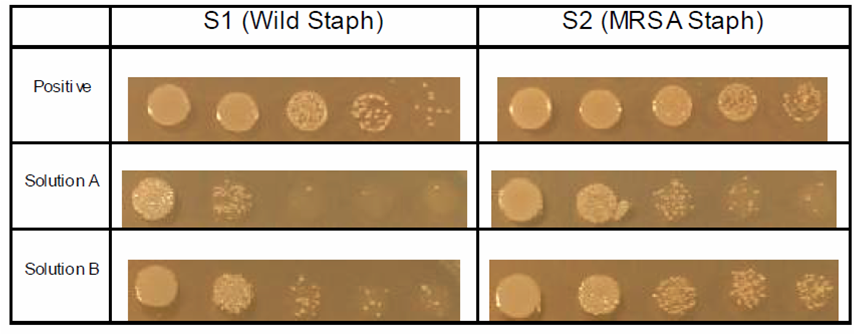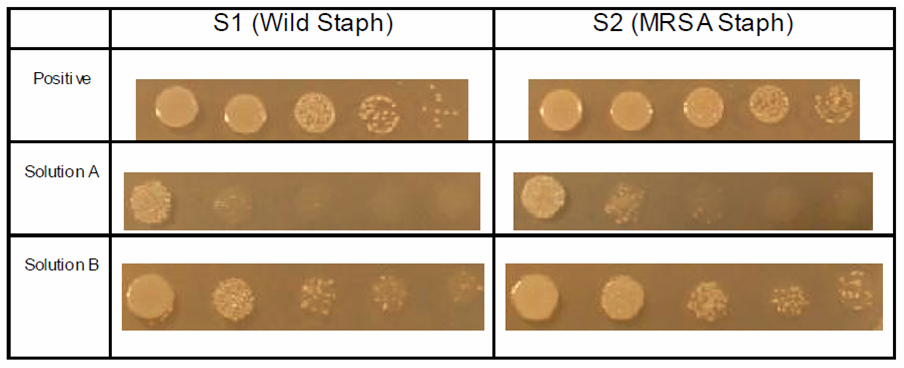Site Kategori Arşivi: bentonit
Gümüş İyonu ve Smektit Grubu Kilin Bakteriler Üzerindeki Etkisi
LABORATUVAR ÇALIŞMASI:
Aşağıda Türkçe ve İngilizce özeti verilen Jason R. Eaton ve Stephen Quinto tarafından yürütülen bir çalışmada, Yüksek kalitede koloidal gümüş ile birleştirilmiş doğal simektit grubu kil (Bentonit) birleştirilmiş ve Staphylococcus Aureus ile MRSA Bakterilerine karşı test edilmiştir. Çalışma sonunda,
Koloidal gümüş ve Bentonit birleşiminin antibakteriyel özelliklerinin geliştiği, sade Bentonitin ise bu birleşime kıyasla antibakteriyel özelliğinin ihmal edilebilir düzeyde olduğu tespit edilmiştir.
Çalışmada özet olarak, değişik kültürlerde ve konsantrasyonlarda hazırlanmış Staphylococcus Aureus (S1) ve MRSA (S2) bakterileri, test için hazırlanan Solüsyon A ve Solüsyon B içinde 3 ve 7 dakikalık periyodlarda bekletilmiş ve sonrasında gözlemler yapılmıştır. Solüsyon A: koloidal gümüş ile birleştirilmiş doğal simektit grubu kil Solüsyonu olarak Solüsyon B: koloidal gümüşsüz hazırlanmış doğal simektit grubu kil Solüsyonu olarak hazırlanmıştır. 3 dakika ve 7 dakika sonrasında yapılan gözlemlere aşağıdaki resim ve tablolarda yer verilmiştir.
Solüsyan A ve Solüsyon B’den 3 dakika sonunda elde edilen sonuçlar:
Solüsyan A ve Solüsyon B’den 7 dakika sonunda elde edilen sonuçlar:
Gözlemlerden de net bir şekilde anlaşılabileceği gibi koloidal gümüş ile birleştirilmiş doğal simektit grubu kil solüsyonunun, antibakteriyel bir özellik gösterdiği, koloidal gümüşsüz hazırlanmış doğal simektit grubu kil solüsyonun ise çok kaydadeğer olmasa da kısmen antibakteriyel özellik gösterdiği görülmektedir.
Bentonit konusunda daha önce yapılan çalışmalar baz alındığında, bakterilere etki şeklinin antibakteriyel özelliğinden kaynaklanmadığı ve bunda ötürü gümüş ile birleştirilmiş bentonite kıyasla bu özelliğinin az olmasının çok şaşırtıcı olmadığıdır. Bentonitin sadece kendisi olarak antibakteriyel özellik taşımadığı zaten bilinmektedir. Bentonit bakterileri öldürerek etki etmez, emme (tutma) yoluyla etkiler. Ancak gümüş ile birleştiğinde antibakteriyel özellik kazanarak da etkilemeye başlar. Bu bağlamda bentonitin bu şekilde antibakteriyel özellik kazanması bentonit için artı bir değer olarak vurgulanmıştır.
Çalışmanın ingilize özetine aşağıda yer verilmiştir.
Oligodynamic Silver & Smectite Time Kill Study
The study was commissioned by Jason R. Eaton of Eytons’ Earth and completed by Stephen Quinto, founder of Natural Immunogenics Corporation. Conducted in April of 2002
This study documents the results of a high quality colloidal silver product combined with natural clay (smectite) and tested against staphylococcus aureus.
The results of the study indicate that the addition of colloidal silver improves the antibacterial properties of a high quality, natural calcium-based smectite against gram positive bacteria (the direct effect that clay has on gram positive bacteria is negligible compared with its effect against other types of pathogens). Conversely, the effectiveness of the silver was reduced.
Method: The antibacterial efficacy of Bentonite — combined with Sovereign Silver (solution A), and without Sovereign Silver (solution B) — was evaluated in this experiment. In a series of dilutions such as are used by this lab in comparing other antibacterial ‘products’, esp. colloidal silvers, both were challenged equally by known pathogens. The clay material used was a pre-prepared mixture This smectite clay (0.1g) was combined with 1 mL of SS to create solution A; similarly (0.1g) the clay was combined with 1 mL of nanopure water to create solution B.Typical YT media was poured into sterile polystyrene plates and allowed to dry overnight. A 3mm scrape of both wild type Staphylococcus aureus (S1) and MRSA Staph (S2) were placed separately into 1250 l of nanopure water to achieve an optical density (O.D.590) of 0.135. From these cultures two standard 10:1 dilution series were performed. Both dilution series were then inoculated, one with solution A, and the other with solution B, and exposed to them for a period of 3 minutes on the one hand and 7 minutes on the other. In the first experiment 10μl of solution A were added to the culture (S1 and S2 dilutions) for 3 minutes; similarly, this was repeated with solution B. In the second experiment 10μl of each solution was added to the respective Staph dilutions and exposed to them for 7 minutes. After the elapsed time, a 10μl spot of cells and solution was placed onto the YT media. A positive control plate of only S1 and S2 was made, as was a negative to ensure no contamination (picture not included-no contamination). The plates were placed in a 37 C incubator overnight and Results: As can be seen from the relative performance of the two formulations, solution A outperformed solution B in both trials, at 3 and 7 minutes. Nonetheless, while solution B (clay alone) showed some antibacterial activity, it was significantly inferior to that of the combined product (solution B). It should be noted, too, that the antibacterial efficacy of solution A is somewhat less than we have come to expect from SS alone (as in similar assays) leading one to hypothesize that some other property is thereby gained in the compromise, surely having to do with the value added by the clay.
Comments: The great infection fighting properties of natural clays have little to do with the antibacterial effect of bentonite. This is something that key researchers have neglected to realize. Most experimentation has been centered around studying clay applications as an intestinal detoxifying agent.
In the body, the clay particles, unless they collect on intestinal walls, etc., are very limited in possible action compared to an undiluted product as used externally. Externally used, the bentonite as a hydrated magma can actually pull an infection out of the body, as the preparation creates a subtle but strong electromagnetic field, which, in an effect that is not fully understood, also stimulates the body’s own natural defenses at the treatment site.
Bentonit Tedavisi Bentonit > bentonit > Sayfa 28








Bir Cevap Yazın